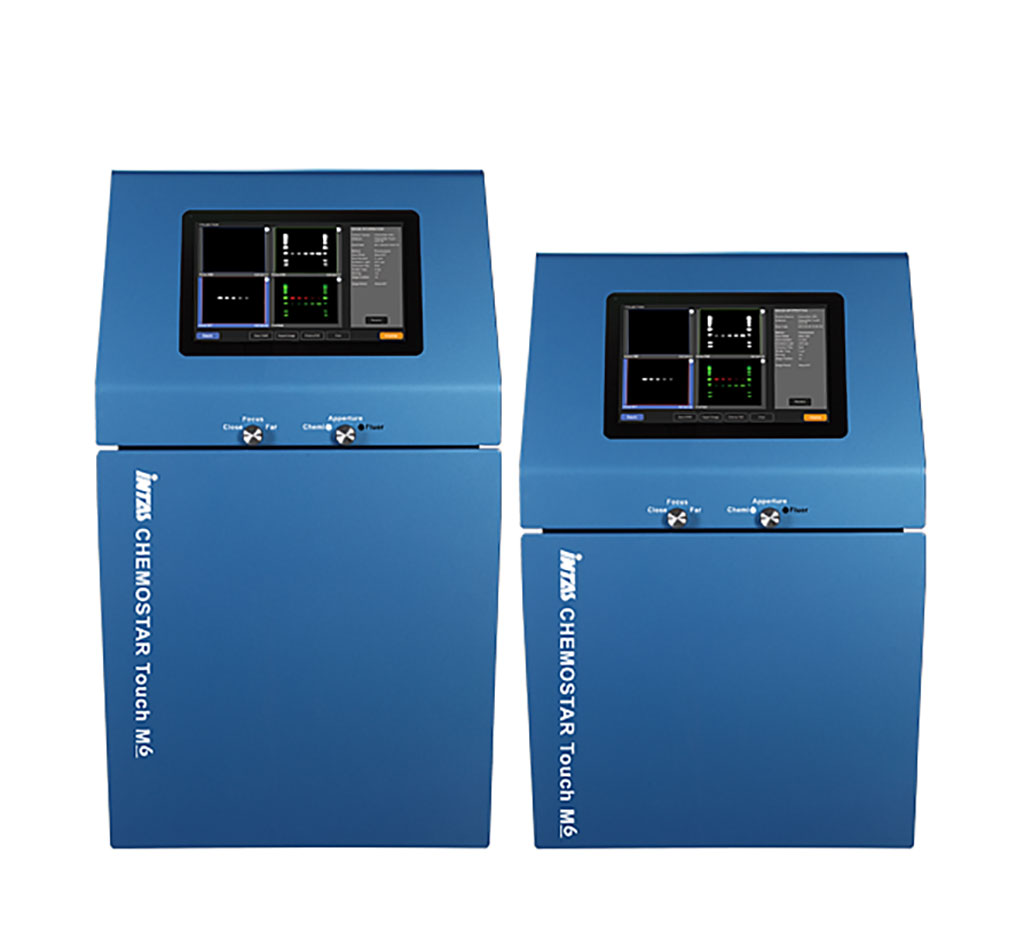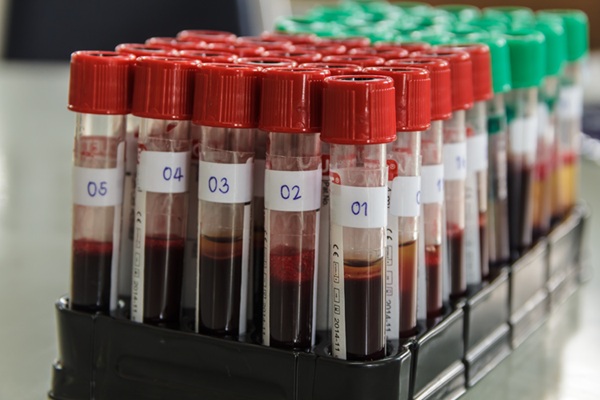Non‐Invasive Urine Markers Differentiate Renal Cancer from Oncocytoma
|
By LabMedica International staff writers Posted on 25 May 2021 |

Image: The CHEMOSTAR Touch ECL & Fluorescence Imager (Photo courtesy of INTAS)
Clear cell renal cell carcinoma, (ccRCC), is a type of kidney cancer. Clear cell renal cell carcinoma is also called conventional renal cell carcinoma. Clear cell renal cell carcinoma is named after how the tumor looks under the microscope.
Renal oncocytoma is a benign (noncancerous) growth of the kidney. They generally do not cause any signs or symptoms and are often discovered incidentally while a person is undergoing diagnostic imaging for other conditions. Some people with renal oncocytoma will have abdominal or flank pain; blood in the urine; and/or an abdominal mass.
Urologists at the University Hospital Cologne (Cologne, Germany) have shown that that Vim3 is overexpressed in tissue samples of renal oncocytomas and Mxi‐2 in clear cell renal carcinoma (ccRCC). They collected urine samples from patients suspected of kidney cancer between 2015 and 2018. The final cohort consisted of 350 patients, with pathohistological proof of an oncocytoma in 20 patients or a RCC (50 chromophobe; 40 papillary); 200 clear cell RCC (ccRCC), as well as 40 negative controls.
The medical scientists performed Western blots on urine samples which were analyzed with INTAS Chemostar (Göttingen, Germany). ELISAs were performed using incubated 3B4 Vimentin antibody and for Mxi‐2 and analyzed on the FLUOstar Omega plate reader (BMG LABTECH, Ortenberg, Germany). The team also carried out lateral flow assays; and quantitative real‐time polymerase chain reaction (qRT‐PCR).
The investigators reported that there was a significant increase of Vim3 in urines from patients with oncocytoma and was detectable with ELISA compared to all other subtypes of RCCs. Mxi‐2 was predominantly overexpressed in ccRCCs. Lateral flow assay of Vim3 and Mxi‐2 shows two bands in the case of oncocytoma and ccRCC indicating the specificity of this test. For small renal masses (SRMs), an overexpression of miR‐15a/Mxi2 was detectable in urine samples from ccRCC and chromoRCC patients. In contrast to that, miR‐498/Vim3 were predominantly overexpressed in oncocytoma patients.
The authors concluded that using the highly specific, non‐invasive urine markers, Vim3 and Mxi‐2, they were able to fill the gap and reduce the number of overtreated patients as well as the number of unnecessary surgeries. Furthermore, even the detection as well as pre‐surgical differentiation in small kidney cancers is possible with the measurement of the two predicted miRs as well as the proteins. Both proteins (Vim3 and Mxi‐2) were detectable in patients’ urines and can be used for the non‐invasive differentiation of kidney cancers. The study was published on May 7, 2021 in the Journal of Clinical Laboratory Analysis.
Related Links:
University Hospital Cologne
INTAS
BMG LABTECH
Renal oncocytoma is a benign (noncancerous) growth of the kidney. They generally do not cause any signs or symptoms and are often discovered incidentally while a person is undergoing diagnostic imaging for other conditions. Some people with renal oncocytoma will have abdominal or flank pain; blood in the urine; and/or an abdominal mass.
Urologists at the University Hospital Cologne (Cologne, Germany) have shown that that Vim3 is overexpressed in tissue samples of renal oncocytomas and Mxi‐2 in clear cell renal carcinoma (ccRCC). They collected urine samples from patients suspected of kidney cancer between 2015 and 2018. The final cohort consisted of 350 patients, with pathohistological proof of an oncocytoma in 20 patients or a RCC (50 chromophobe; 40 papillary); 200 clear cell RCC (ccRCC), as well as 40 negative controls.
The medical scientists performed Western blots on urine samples which were analyzed with INTAS Chemostar (Göttingen, Germany). ELISAs were performed using incubated 3B4 Vimentin antibody and for Mxi‐2 and analyzed on the FLUOstar Omega plate reader (BMG LABTECH, Ortenberg, Germany). The team also carried out lateral flow assays; and quantitative real‐time polymerase chain reaction (qRT‐PCR).
The investigators reported that there was a significant increase of Vim3 in urines from patients with oncocytoma and was detectable with ELISA compared to all other subtypes of RCCs. Mxi‐2 was predominantly overexpressed in ccRCCs. Lateral flow assay of Vim3 and Mxi‐2 shows two bands in the case of oncocytoma and ccRCC indicating the specificity of this test. For small renal masses (SRMs), an overexpression of miR‐15a/Mxi2 was detectable in urine samples from ccRCC and chromoRCC patients. In contrast to that, miR‐498/Vim3 were predominantly overexpressed in oncocytoma patients.
The authors concluded that using the highly specific, non‐invasive urine markers, Vim3 and Mxi‐2, they were able to fill the gap and reduce the number of overtreated patients as well as the number of unnecessary surgeries. Furthermore, even the detection as well as pre‐surgical differentiation in small kidney cancers is possible with the measurement of the two predicted miRs as well as the proteins. Both proteins (Vim3 and Mxi‐2) were detectable in patients’ urines and can be used for the non‐invasive differentiation of kidney cancers. The study was published on May 7, 2021 in the Journal of Clinical Laboratory Analysis.
Related Links:
University Hospital Cologne
INTAS
BMG LABTECH
Latest Immunology News
- Chip Captures Cancer Cells from Blood to Help Select Right Breast Cancer Treatment
- Blood-Based Liquid Biopsy Model Analyzes Immunotherapy Effectiveness
- Signature Genes Predict T-Cell Expansion in Cancer Immunotherapy
- Molecular Microscope Diagnostic System Assesses Lung Transplant Rejection
- Blood Test Tracks Treatment Resistance in High-Grade Serous Ovarian Cancer
- Luminescent Probe Measures Immune Cell Activity in Real Time
- Blood-Based Immune Cell Signatures Could Guide Treatment Decisions for Critically Ill Patients
- Novel Tool Predicts Most Effective Multiple Sclerosis Medication for Patients
- Companion Diagnostic Test for CRC Patients Identifies Eligible Treatment Population
- Novel Tool Uses Deep Learning for Precision Cancer Therapy
- Companion Diagnostic Test Identifies HER2-Ultralow Breast Cancer and Biliary Tract Cancer Patients
- Novel Multiplex Assay Supports Diagnosis of Autoimmune Vasculitis
- Blood Test Predicts Immunotherapy Efficacy in Triple-Negative Breast Cancer
- Simple Genetic Testing Could Predict Treatment Success in Multiple Sclerosis Patients
- Novel Gene Signature Predicts Immunotherapy Response in Advanced Kidney Cancers
- New Technology Deciphers Immune Cell Communication to Predict Immunotherapy Response
Channels
Molecular Diagnostics
view channel
New Biomarker Panel to Improve Heart Failure Diagnosis in Women
Heart failure affects millions worldwide, yet many women are still misdiagnosed or diagnosed too late. Although heart failure broadly means the heart cannot pump enough blood to the body’s cells, its two... Read more
Dual Blood Biomarkers Improve ALS Diagnostic Accuracy
Diagnosing amyotrophic lateral sclerosis (ALS) remains difficult even with advanced imaging and genetic tools, especially when clinicians must distinguish it from other neurodegenerative conditions that... Read moreHematology
view channel
ADLM’s New Coagulation Testing Guidance to Improve Care for Patients on Blood Thinners
Direct oral anticoagulants (DOACs) are one of the most common types of blood thinners. Patients take them to prevent a host of complications that could arise from blood clotting, including stroke, deep... Read more
Viscoelastic Testing Could Improve Treatment of Maternal Hemorrhage
Postpartum hemorrhage, severe bleeding after childbirth, remains one of the leading causes of maternal mortality worldwide, yet many of these deaths are preventable. Standard care can be hindered by delays... Read more
Pioneering Model Measures Radiation Exposure in Blood for Precise Cancer Treatments
Scientists have long focused on protecting organs near tumors during radiotherapy, but blood — a vital, circulating tissue — has largely been excluded from dose calculations. Each blood cell passing through... Read moreImmunology
view channel
Chip Captures Cancer Cells from Blood to Help Select Right Breast Cancer Treatment
Ductal carcinoma in situ (DCIS) accounts for about a quarter of all breast cancer cases and generally carries a good prognosis. This non-invasive form of the disease may or may not become life-threatening.... Read more
Blood-Based Liquid Biopsy Model Analyzes Immunotherapy Effectiveness
Immunotherapy has revolutionized cancer care by harnessing the immune system to fight tumors, yet predicting who will benefit remains a major challenge. Many patients undergo costly and taxing treatment... Read moreMicrobiology
view channel
High-Throughput Enteric Panels Detect Multiple GI Bacterial Infections from Single Stool Swab Sample
Gastrointestinal (GI) infections are among the most common causes of illness worldwide, leading to over 1.7 million deaths annually and placing a heavy burden on healthcare systems. Conventional diagnostic... Read more
Fast Noninvasive Bedside Test Uses Sugar Fingerprint to Detect Fungal Infections
Candida bloodstream infections are a growing global health threat, causing an estimated 6 million cases and 3.8 million deaths annually. Hospitals are particularly vulnerable, as weakened patients after... Read morePathology
view channel
Highly Sensitive Imaging Technique Detects Myelin Damage
Damage to myelin—the insulating layer that helps brain cells function efficiently—is a hallmark of many neurodegenerative diseases, age-related decline, and traumatic injuries. However, studying this damage... Read more
3D Genome Mapping Tool to Improve Diagnosis and Treatment of Genetic Diseases
Standard laboratory tests often fail to detect complex DNA rearrangements that underlie many genetic diseases. To bridge this diagnostic gap, researchers have developed a 3D chromosome mapping method that... Read more
New Molecular Analysis Tool to Improve Disease Diagnosis
Accurately distinguishing between similar biomolecules such as proteins is vital for biomedical research and diagnostics, yet existing analytical tools often fail to detect subtle structural or compositional... Read more
Tears Offer Noninvasive Alternative for Diagnosing Neurodegenerative Diseases
Diagnosing and monitoring eye and neurodegenerative diseases often requires invasive procedures to access ocular fluids. Ocular fluids like aqueous humor and vitreous humor contain valuable molecular information... Read moreTechnology
view channel
Portable Biosensor Diagnoses Psychiatric Disorders Using Saliva Samples
Early diagnosis of psychiatric disorders such as depression, schizophrenia, and bipolar disorder remains one of medicine’s most pressing challenges. Current diagnostic methods rely heavily on clinical... Read more
Cell-Sorting Device Uses Electromagnetic Levitation to Precisely Direct Cell Movement
Sorting different cell types—such as cancerous versus healthy or live versus dead cells—is a critical task in biology and medicine. However, conventional methods often require labeling, chemical exposure,... Read moreIndustry
view channel
Co-Diagnostics Forms New Business Unit to Develop AI-Powered Diagnostics
Co-Diagnostics, Inc. (Salt Lake City, UT, USA) has formed a new artificial intelligence (AI) business unit to integrate the company's existing and planned AI applications into its Co-Dx Primer Ai platform.... Read more






















